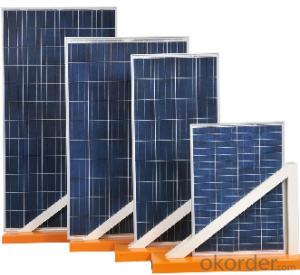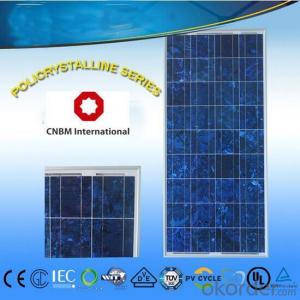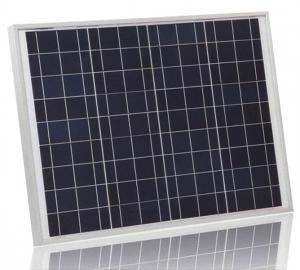Energy Solar Panels - Polycrystalline Solar Panel (25w-310w)
- Loading Port:
- Shanghai
- Payment Terms:
- TT OR LC
- Min Order Qty:
- 100 pc
- Supply Capability:
- 500000 pc/month
OKorder Service Pledge
OKorder Financial Service
You Might Also Like
Polycrystalline Solar Panel Details:
I Solar Cell : High efficiency crystalline solar cell. Even if under the weak light, the solar module can produce maximum power output.
II Tempered glass (toughened glass): Anti-reflecting coating and high transmission rate glass increase the power output and mechanical strength of solar module.
III EVA and TPT: Using high quality EVA and TPT to prevent destroying and water.
IV AI frame: Without screw, corner connection. 6 holes on the frame can be installed easily.
V Junction box: Multi function junction box with water proof.
VI Long lifetime: ≥25 years; Less power decrease.
VII Good performance of preventing from atrocious weather such as wind and hails.
VIII Resisting moisture and etching effectively, not effected by geology. .
Temperature Coefficient of Polycrystalline Solar Panel
NOCT | 47℃±2℃ |
Temperature Coefficients of Isc (%/℃) | 0.064 |
Temperature Coefficients of Voc (%/℃) | -0.33 |
Temperature Coefficients of Pmp (%/℃) | -0.45 |
Operating Temperature | –40 °C to +85°C |
Storage Temperature | –40 °C to +85°C |
Max System Voltage | 700V |
Products Guarantee | 2 yrs free from defects in materials and workmanship |
Performance Guarantee | No less than 90% within 10yrs and no less than 80% within 20yrs |
Certificates | ISO, TUV, CE |
Standard Test Conditions of Polycrystalline Solar Panel
The opto-electrical specifications shown below are stabilized values being measured at Standard Test Conditions of multicrystalline silicon Solar Panel, Irradiance: 1000W/m2, Spectrum: AM1.5 at 25°C, The info below is subject to manufacturing tolerances. Where appropriate minutes of measurement are available and are used for the dimensioning of the installation.
Advantages of Polycrystalline Solar Panel
• CNBM Solar performance guarantees for 25 years
• 12 years guarantee for workmanship for multicrystalline silicon Solar Panel
| Minimum Order Quantity: | 40pcs watt | Unit: | watt | Loading Port: | SHANGHAI Port |
| Supply Ability: | 200MWPer year watt/month | Payment Terms: | TT or LC |
Product Description:
Details Of Polycrystalline Solar Panel
Product Description of Polycrystalline Solar Panel
CNBM Solar Polycrystalline Series (25W—310W)
CNBM Solar photovoltaic (PV)module is designed for large electrical power requirements. It is the optimal choice for both on-grid and off-grid power systems. CNBM Solar panel offers high performance of power per square foot of solar array.Poly- or multicrystalline silicon(poly-Si or mc-Si): made from cast square ingots — large blocks of molten silicon carefully cooled and solidified. Poly-Si cells are less expensive to produce than single crystal silicon cells, but are less efficient. US DOE data shows that there were a higher number of multicrystalline sales than monocrystalline silicon sales.
- Q: i am trying to figure out how many solar panels can be placed on one acre of land and how much they cost to install
- Commercial Solar Panels Cost
- Q: in the afternoon sun heat increases to high level due to which the panels heats up very high now my question is this heat will effect the panels life time and will damage the panels or not ??
- They degrade over time, losing efficiency. They're generally good for several decades.
- Q: I'm looking to see how much it would be to install solar panels on a home. Or more information on where i would be able to locate a place of purchase, or in general more information...
- If you hope to get a solar panel that can run appliances and air conditioning.. then you are not even close to being realistic about what solar panels can do. If you really want to install a solar panel array on your home, then you need to talk to a company in your area that designes and installes them because every installation is different.. so you won't get an answer here on Yahoo. You can expect to spend $20,000 to $30,000 that will provide enough solar power for the average home.
- Q: Can solar panels be used for powering a theme park or amusement park?
- Yes, solar panels can definitely be used for powering a theme park or amusement park. Solar energy is a clean and renewable source of power that can effectively generate electricity for various operations within a park, such as lighting, rides, and even water heating systems. By utilizing solar panels, theme parks can significantly reduce their reliance on traditional fossil fuels, lower their carbon footprint, and contribute to a more sustainable and environmentally friendly operation.
- Q: Can solar panels be installed on water bodies or reservoirs?
- Yes, solar panels can be installed on water bodies or reservoirs. This is known as floating solar or floating photovoltaic (FPV) technology. It involves mounting solar panels on buoyant platforms on the surface of the water. This approach offers several benefits, including reduced land requirements, increased energy generation due to the cooling effect of water, and reduced evaporation from the water body.
- Q: I know that the Solar panels store the power from the sun in the daytime, where does that stored energy go from there? Is it stored in the batteries? And how would you keep the batteries topped up if you had no Electric? by a generator? interested in solar panels for abroad, but need more info.
- solar panels collect the suns energy and turns that into electricity that is then stored in batteries. attached to the batteries is another device that takes the power from the batteries and turns it into power you can use in your house. it is a very expensive power alternative.
- Q: hi, i got a pond and i am planning of putting some lights on it during night time. but i want to use solar panels and i have done a bit of research about solar panels and i know how they work, i know that the common voltage to use is 2v so you can use car batteries or deep cycle batteries, but my question is:. what wattage of bulb can you recommend2. how long it would take to drain my battery (can i have it overnight)3. and what wattage of solar panel should i get enough to recharge my battery the next day.hope anyone can help..thanks
- You can get 6V cells and SLA batteries. You would get a panel and batteries suitable for the lights you get though. Depending on what you want to do, you shoud look into LED lighting, which is more efficient than incandescent. You do not want to drain your battery flat. Rather you want to draw only 2/3 of its capacity of so. You would find the lights you want (likely 2VDC), and add up the current they draw, and get a battery that would supply enough capacity (in AH, which is amps time hours) for a couple nights use (to account for weak solar days), and a solar panel to charge two days of use in one good day. You would use a charge controller so that the solar panel does not over charge the battery, and some sort of dusk timer to turn your lights on at dusk and off several hours later.
- Q: Can solar panels be used for off-grid living?
- Yes, solar panels can be used for off-grid living. They provide a reliable and sustainable source of electricity by converting sunlight into usable energy. This makes them ideal for powering homes, cabins, or even recreational vehicles in remote areas where access to the utility grid is limited or unavailable. Solar panels enable off-grid living by storing excess energy in batteries, allowing for electricity usage during nighttime or cloudy days.
- Q: Can solar panels be used in areas with high levels of air humidity or moisture?
- Yes, solar panels can be used in areas with high levels of air humidity or moisture. While excessive moisture can potentially reduce the efficiency of solar panels, modern solar panel designs are equipped to handle such conditions. They are built with protective coatings and materials that prevent moisture penetration and corrosion. Additionally, regular maintenance and cleaning can further ensure optimal performance in humid environments.
- Q: Can solar panels be used to power swimming pools or hot tubs?
- Yes, solar panels can be used to power swimming pools or hot tubs. Solar energy can be harnessed through solar panels and converted into electricity to operate the pumps, heaters, and other equipment required to maintain the desired temperature and cleanliness of the water in swimming pools or hot tubs.
Send your message to us
Energy Solar Panels - Polycrystalline Solar Panel (25w-310w)
- Loading Port:
- Shanghai
- Payment Terms:
- TT OR LC
- Min Order Qty:
- 100 pc
- Supply Capability:
- 500000 pc/month
OKorder Service Pledge
OKorder Financial Service
Similar products
Hot products
Hot Searches
Related keywords


























